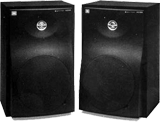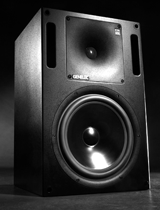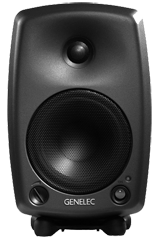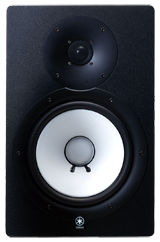 Q It Up: What monitors do you use for mixing, and how do you use them? Do you use near-field monitors? Or do you use large monitors hanging from the ceiling? Maybe you use a cheap cue speaker. Maybe you use all three! Do you think headphones can be of any use in monitoring mixes? Do you mix with the monitors turned up loud, down low, somewhere in the middle? And finally, how different are your ears from the ears of your Program Director(s) or your clients? How often do you have to remix a spot or promo because somebody else’s ears heard the mix differently? Please add any other thoughts you have on the fine art of mixing.
Q It Up: What monitors do you use for mixing, and how do you use them? Do you use near-field monitors? Or do you use large monitors hanging from the ceiling? Maybe you use a cheap cue speaker. Maybe you use all three! Do you think headphones can be of any use in monitoring mixes? Do you mix with the monitors turned up loud, down low, somewhere in the middle? And finally, how different are your ears from the ears of your Program Director(s) or your clients? How often do you have to remix a spot or promo because somebody else’s ears heard the mix differently? Please add any other thoughts you have on the fine art of mixing.
 Johnny George [vo[at]johnnygeorge.com], www. johnnygeorge.com: I’ve been using my original JBL 4208 speakers as my main and only monitors since 1993. Love ‘em. Most of my work is VO only, but on projects that require some production, I do a variety of things. I listen to the mix at low, mid and high volumes to judge my mix. When I need to see if it really is cutting through , I turn up my head phones and listen to them as they sit on my counter. The mix between the VO and the music/efx are critical and processing in the final chain is the determining factor.
Johnny George [vo[at]johnnygeorge.com], www. johnnygeorge.com: I’ve been using my original JBL 4208 speakers as my main and only monitors since 1993. Love ‘em. Most of my work is VO only, but on projects that require some production, I do a variety of things. I listen to the mix at low, mid and high volumes to judge my mix. When I need to see if it really is cutting through , I turn up my head phones and listen to them as they sit on my counter. The mix between the VO and the music/efx are critical and processing in the final chain is the determining factor.
When I was in radio and my promo’s were on our air, I always had to listen to what it sounded like through our processing to get a handle on what the compression and limiting was doing to my work. Once you understand that, you are miles ahead in perfecting your mix. Needless to say, there were times I hear the VO buried or something outta whack and I’d go back and re-mix ASAP. This of course relies on the intelligence of your engineers’ settings and how other do theirs - and that’s a whole other story.
Wawro, Wally [wwawro[at]wfaa.com], WFAA-TV Creative Services, Dallas, Texas: WFAA-TV is standardized on the venerable Electro Voice Sentry 100 monitors. They are in all control rooms and the critical production suites. In my audio post room I also use an M&K subwoofer for some extra beef. I don’t mix in 5.1 surround as we still have some infrastructure issues to deal with. Our power amplifiers are usually Bryston 2B and 3B amps, we also have some Crown units in use.
I use a set Klipsch computer monitors as well as small speakers. They sound like crap, which works for me!
Craig Jackman [Craig.Jackman[at]ottawaradio.rogers.com], Rogers Media, Ottawa, Ontario, Canada: In the old company in the old building, we had large monitors hanging from the ceiling. They were great when it was cranked up, but the speakers were really good at fooling your ear. When I had the chance to build some smaller studios we put smaller nearfield monitors in, and I think it’s made a big difference in the accuracy of what I’m hearing. In my current studio I have an older set of small Genelecs with a powered sub, and I find them just about perfect for how I need to hear things. In the other studios we have either self powered or unpowered Tannoy Reveal’s, and they are pretty good as well. The one thing I always fall back on if I’m not certain about how I’m mixing something is to listen through a cue speaker. The only reason I keep an Otari reel-to-reel in the studio is that it has a cheap built in cue speaker. Sometimes listening to something in mono through an underpowered 2” speaker will really show where you are overpowering the mix. I never ever monitor on headphones... unless I don’t have a cue speaker. Then I’ll turn up the headphones a little and leave them on the desktop, using that as a cue speaker. Since I’ve gone to the nearfields, and checking my mix on a cue speaker, I almost never get PD or client remix requests. When I do, they were right, I buried something in the mix that needed to stand out more... and by almost never, I mean once or twice in the last 10 years. It also couples with something a former PD told me about how he wants the promos to sound: “Make the voice cut through.” If the voice isn’t cutting through, you are just wasting air time.
 Dave Spiker [davespiker[at]aol.com]: I use Genelec 1032’s for main monitors. But I check on several small, inexpensive speakers including my laptop’s internal speakers. Sometimes, I’ll even listen to a mix through the headphones as they lay on the desk. An old timer once told me, the best way to check a mix is to turn the level down to where you can barely hear it above the ambient sound in the room. Then you’ll be able to tell what gets “lost” in the mix. I’ll also listen to a mix in my car -- that’s probably the environment where most listeners will hear the material anyway. But, having rented dozens of cars on various business trips, I’m aware the frequency response in different cars can vary enormously. So the car test is sort of a last check for me.
Dave Spiker [davespiker[at]aol.com]: I use Genelec 1032’s for main monitors. But I check on several small, inexpensive speakers including my laptop’s internal speakers. Sometimes, I’ll even listen to a mix through the headphones as they lay on the desk. An old timer once told me, the best way to check a mix is to turn the level down to where you can barely hear it above the ambient sound in the room. Then you’ll be able to tell what gets “lost” in the mix. I’ll also listen to a mix in my car -- that’s probably the environment where most listeners will hear the material anyway. But, having rented dozens of cars on various business trips, I’m aware the frequency response in different cars can vary enormously. So the car test is sort of a last check for me.
 Heikki Wichmann [Heikki.Wichmann[at]nrj.fi], NRJ, Helsinki, Finland: Here is short answer: I use Genelec 8030A near-field monitors and a Genelec 7050B subwoofer. They give nice and very neutral sound and wide enough frequency band.
Heikki Wichmann [Heikki.Wichmann[at]nrj.fi], NRJ, Helsinki, Finland: Here is short answer: I use Genelec 8030A near-field monitors and a Genelec 7050B subwoofer. They give nice and very neutral sound and wide enough frequency band.
Distance to ear is about 1 meter, so I can call it near-field monitoring.
I added a subwoofer to the system because I want to hear all the unwanted microphone pops and ambient noises. When I hear those sounds I can mix them down, if I want to.
I try to use as low volume as I can. When I’m doing the final mixing (mastering) I listen a little bit louder, but not very loud.
I don’t use headphones because stereo imaging doesn’t sound the same as from speakers.
Sometimes I have to mix a little differently, mostly because some customer who doesn’t know anything about audio wants to. They say the music is too loud or too low, etc., and they are mostly listening from lousy lap-top speakers.
I mix an mp3 for them and use a different mix on-air. They don’t realize that the on-air processing really does a lot of magic to the sound (good and bad magic anyway).
Blaine Parker [bp[at]slowburnmarketing.com]: I probably shouldn’t admit this, but I spent years working around audiophile gear, and I simply don’t use anything nearly as good in my own studio.
I work on a pair of M-Audio BX-8s, a bi-amped near-field monitor with a 1-inch silk-dome tweeter and an 8-inch, mineral-filled polypropylene woofer.
I listen to mixes on a pair of Avantone Mixcubes, which are kind of like a sexier version of the ever-popular Auratone. Same size, but updated for the digital age. (And less expensive than what you’ll pay for the, uh, antique “real deal” on Ebay.)
I have no use for headphones unless I’m cutting VO in a hotel room, or monitoring the recording of a subject on location. In mixing, phones can over-emphasize nuances and cause one to mix those sounds too low for the real world listener to hear. (Ask Jay Rose. He’ll tell ya. Better yet, buy his book, Audio Postproduction for Digital Video. More than one person I’ve turned onto it has found it insanely useful despite the seemingly video-centric nature of the title.)
I’ve found that my ears are such that I now need to hear things LOUD to hear it all. Let’s just say that I’m a bastard poster child for the Fletcher-Munson curve. But I can still pick out subtleties that many other people miss, especially mouth noises. My wife spent many years working on Madison Avenue, which came with many hours in spot postproduction. She has hearing like a bat as well as an aversion to mouth noises and anything else that sounds wrong, and she’s still amazed when I pick out these errant glottal clicks she never heard.
 Shane Hurford [shano[at]c913.com.au], c91.3, Sydney, Australia: At work we have Landmark nearfields - okay but not great. More like domestic monitors (which isn’t an altogether bad thing).
Shane Hurford [shano[at]c913.com.au], c91.3, Sydney, Australia: At work we have Landmark nearfields - okay but not great. More like domestic monitors (which isn’t an altogether bad thing).
The danger with domestic speakers is the tendency to “warm over” the bass sound to compensate for what you can’t hear, or the opposite, speakers that have been warmed over and the producer EQs it out.
At home, Yamaha HS80 -- pretty good but I still need to check on some crappier speakers and the car stereo just to reference. The Yamahas need a little bit of volume to sound their best.
I find I tend to give the monitors a bit of volume if I’m trying to hear how harmonics react with each other or to tighten a bass sound or need to hear reverb properly, or if I’ve just made something I really like.
Previous studios I’ve worked at provide the big thumping speakers, some near fields (sometimes 2 or 3 pair) and 1 crappy mono speaker. This array usually gives enough variety in monitoring conditions so as to accurately reflect how stuff will sound out in the market place.
It may sound great on your $4000 speakers, but if it sounds like crap in the car or on the radio next to the bed, then what’s the point?
Sometimes the most insightful monitoring is done by the sales rep who walks in half way through the mix and says, “what’s that whirling noise?” Of course you missed it because you were head down, tail up, checking the feedback on the second harmonic due to parasitic oscillations... or something like that.
Andrew Frame [andrew[at]bafsoundworks.com], BAFSoundWorks, Lehigh Acres, Florida: A pair of JBL-4311 Control Monitors from the mid 1970’s. I’ve had them since they were brand new. They really are designed to be quite a bit further away than I have them, but the room is small, so they’re upside-down on stands about one meter from my chair, with the tweeter/mids array at head level. (The 4311’s were built with the woofer on top, and the tweeter/mid pair on the bottom, so when hung from the wall or ceiling, the mid/highs would be closer to ear level.)
The room I’m in is pretty well coupled to the next, sharing a common wall that is in no way sound-deadening. So I use a low to moderate mix level most of the time. When unoccupied, though, I’ll run a higher volume. Too loud causes ear fatigue too quickly, so a moderate level is always the starting point.
I haven’t used headphones for anything in so long (20 years or so) so I can’t respond to anything regarding them.
I can’t think of the last time I had anyone ask for a remix, but if they did, I’d gladly comply. It’s not a big deal; this isn’t some fantastic legacy of sonic artwork we do every day. They’re sales messages and we make them by the thousands. At least if I get asked for a remix, I’ll know someone on the receiving end is paying attention.
Ryan Drean [ryandrean[at]gmail.com], www.RyanOnTheRadio.com, Dallas, Texas: I figure my two-cents may be echoed by multiple submissions but its very important when monitoring. Listen to every mix in a small, cheap, crappy MONO speaker. MONO is the key word. Either you learned this because you were already well educated in phasing, you heard it from another producer, or the hard way, like me. I had been in my first full-time imaging gig for about a month or so. I made what I thought was an “amazing” promo and honestly couldn’t wait to hear it on air. I dubbed it in, went to my car and listened... the promo played, with no voice. I was dumbfounded because I didn’t really use too much stereo/spread fx on the VO. I was aware that a producer can get too fancy with shoving tracks left and right thus canceling them out, but I hadn’t done that. The problem was the original track I got from the voice talent was out of phase (recorded in stereo which is a whole other problem) and I didn’t check my mix in mono. So check your mix in mono. Also record your VO tracks in mono, but again that’s not really for this Q-it-up.
Otherwise I never mix with headphones. I also never mix in the BIG speakers hanging from the ceiling. I figure a pretty small percentage of the audience is listening with headphones or on monster sized speakers. I prefer near field monitors with pretty low bass response.
As for the PD’s ears, they are like mine 99% of the time, though ironically about a week ago was the first time in years he asked me to bring down the background mx and fx. The “client” is the opposite. Years ago I would get “bring down the background music” far too often so when I do produce (pretty rarely these days) commercials I don’t even bother trying to mix them how I think they should sound. LOW background mx is always best in those situations, I think.
Lee Rugen [lee.rugen[at]moody.edu], Moody Radio, Chicago, Illinois: My first edits are often with the headphones so I can catch as many of the smaller details as possible (i.e. breaths, music edits, “p” pops, fades). Then I try to listen to the mix on all different types of speakers in different settings. It helps me know how the spot will come across in various environments so I can find the right mix in regards to things like EQ and music/VO balance. Usually I’ll listen on the speakers in my office at different levels, then turn up the headphones and lay them on my desk, go into a larger studio and listen on those speakers, and finally on my MacBook Pro through iTunes.
Over the years I’ve picked up quite a few tips and suggestions from the real audiophiles that I’ve worked with, but if time allows and I’m not quite sure of the mix, I’ll still occasionally run it past some of my peers to see what they think. We’ve got a great working relationship here and we try to bounce ideas off of each other. Some co-workers have more expertise in certain areas and it helps me do a better job to recognize that I can learn a great deal from the input from others. We may not always agree, but it can help to get an outside opinion from time to time... and it helps all of us realize that none of us is perfect.
Scott Paulette [scott[at]equipfm.org], Equip FM, Lynchburg, Virginia: And from the low budget, el cheapo corner of the audio world…
I mix almost exclusively for radio, and ever since I read an article many moons ago that said you should check your mix through a speaker similar to a car speaker, I’d done most of my monitoring through the cue speaker. Lately I mix through a pair of Harmon/Kardon computer speakers! My present scenario is based on a limited budget, so we’re using some small Fostex powered monitors for the studio/control room, much to my engineers dismay! I always wanted to try some Auratones during their heyday, but now that they’re gone (except for the used ones floating around). I suppose Avantones would be the ones to hear now for something along those lines.
♦

